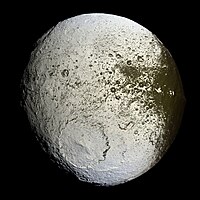
Photo from wikipedia
Secondary impact craters, features created by projectiles ejected from a primary impact, contain important information about the primary cratering event and the nature and distribution of its ejecta. The Orientale… Click to show full abstract
Secondary impact craters, features created by projectiles ejected from a primary impact, contain important information about the primary cratering event and the nature and distribution of its ejecta. The Orientale impact basin (D similar to 930km) is the youngest and the least degraded large impact basin on the Moon and has the most recognizable secondary impact craters. We identified and mapped 2,728 secondary craters in the investigated area of similar to 1.66x10(7)km(2), covering an area from the rim of Orientale to six radii. Secondary crater diameters range from similar to 2 to 27km, and the median diameter decreases as distance increases. Secondary craters are concentrated predominantly in the northwest and southwest. The ejecta deposit pattern inferred from secondary crater distribution suggests that the Orientale basin was formed by an oblique impact in which the downrange direction was 240 degrees-265 degrees in azimuth, and the incidence angle was steeper than 20 degrees. The cumulative size-frequency distribution of mapped secondary craters steepens as diameter increases and is very well approximated with a Weibull distribution with an exponent 1.32. A widely used crater scaling relationship predicts that the fragments that produced the secondary craters were predominantly in similar to 0.5-2-km diameter range over the investigated area; the diameter of the largest fragment, however, decreases with increasing distance from Orientale. On the basis of the diameter of the largest secondary crater of Orientale, and other craters and basins, the largest secondary crater of the South Pole-Aitken basin is estimated to be similar to 40km in diameter. We explore the implications of these findings for the evolution of the megaregolith and future sample return missions.
Journal Title: Journal of Geophysical Research
Year Published: 2018
Link to full text (if available)
Share on Social Media: Sign Up to like & get
recommendations!